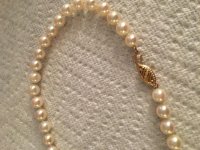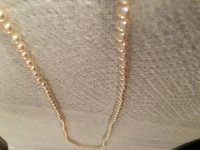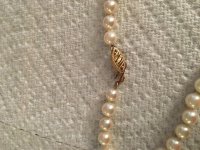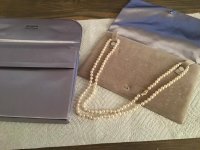Welcome, Kade! What a nice gift for your grandmother to pass along. Many people inherit pearls, but I particularly like it when the gift is given while the giver is still alive and can share their personal history.
So I'm guessing with the history, appearance and tooth test, that you have a nice strand of cultured akoya pearls. Akoya pearls are saltwater pearls cultured in Japan that have a shell bead nucleus (which is why they are so round.)
Akoyas from the 1950s have thicker nacre than many of the strands exported from Japan in the 1970s and 1980s. This is a good thing: thick nacre means better luster and greater durability. If you take care of them, you should be able to enjoy them the rest of your life and pass them down to the next generation.
• Pearls have a soft surface that is easily scratched, and is damaged by common products like hair spray, perfume, lotions. Store them away from other jewelry that could scratch them-- that case is fine, or a soft pouch, or a separate drawer in a jewelry box. Don't keep them in a safe deposit box-- the environment is too dry.
• Apply cosmetic products first, and put your pearls on last.
• When you take them off, wipe them with a soft, dry (or very slightly damp, if it was a hot sweaty day or if you were wearing lotion) cloth before putting them away. I like microfiber for this as it is good at removing skin oils from the pearls.
• Restring them once per year if you wear them often. Many of us restring our own pearls. Tutorials are available here on P-G, on the Lowly Beaders Club forum. If the knots look dirty, or if there are gaps between the pearls, it's time for restringing. Silk becomes weaker when wet or dirty and it absorbs oils. (This is why many of us restring with a synthetic thread.)
You mentioned how many pearls there are but not how long the strand is, so we can estimate pearl size.





